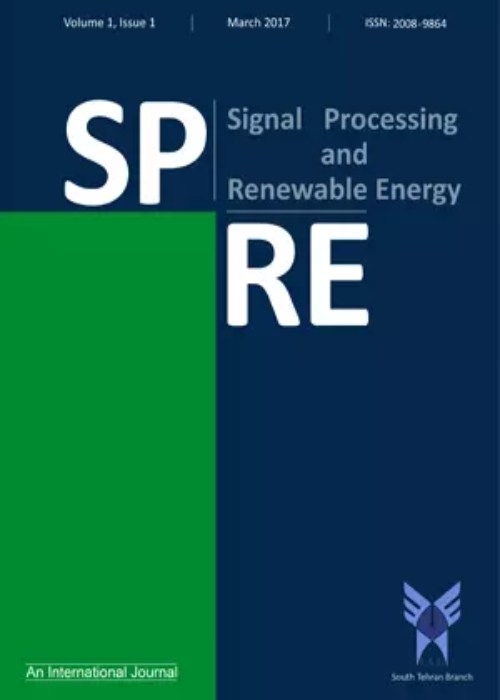فهرست مطالب
Signal Processing and Renewable Energy
Volume:1 Issue: 2, Spring 2017
- تاریخ انتشار: 1396/03/11
- تعداد عناوین: 6
-
Pages 1-10
In this investigation, automatic face recognition algorithms are discussed. For this purpose, a combination of learning algorithms with supervision are realized; in this way, the classification is first designed by the fuzzy-based support vector machine and then the AdaBoost meta-algorithm is applied to the designed classification to reach more accuracy and overfitting control. In the research proposed here, in order to address the effects of asymmetric classes, the adaptive coefficients are employed. In addition, to reduce the data size, the principal components analysis is also applied to the raw data. It is to note that the proposed approach is carried out in a set of images extracted from Yale University data set and its accuracy of the proposed one is verified.
Keywords: face recognition, Classification, fuzzy-based support vector machine, Adaboost -
Pages 11-22In this paper, a method to compute optimum impedance of fault current limiter (FCL) is presented. The type of FCL impedance based on its resistance, inductance and capacitance has an effect on the amount of short circuit current reduction. Therefore, for an optimum result a complex parameter is selected for the FCL impedance. In addition, magnitude of short circuit current is also affected by location of FCL and the amount of system parameter. Due to the cost difference of real and imaginary components of FCL impedance, this calculation is based of sensitivity analysis, such that while minimizing the cost of impedance parts for FCL, reduction in fault current is maximized. Moreover, based on the maximum allowable current constraint and using a developed computer program, an optimum FCL impedance for a wide range of prices for real and imaginary components are computed. These analyses were applied on a 11 bus test system with using a specified single location of FCL.Keywords: Optimum impedance, Short circuit current, Fault current limiter (FCL)
-
Pages 23-26controlling and suppressing sidelobe level of a symmetric parabolic antenna is presented. This sidelobe suppression is done by adding three disc-shaped elements on the surface of the parabolic antenna. By adjusting the position and height of these elements, the surface of the side lobe is changed. With this method, the antenna is designed in the X-Band so that the output of the radiation pattern is such that the level of the first side lobe is relatively lower than the other side lobe. Also, the VSWR for the antenna is designed across the frequency range below 1.82. The simulations show that the level of the first side lobe on the right side of the antenna radiation pattern is reduced by 18dB compared with the simple reflex antenna with similar dimensions and specifications, and the VSWR in the frequency range (11.5GHz-12.5GHz) between 1.1 <VSWR <1.82 .Keywords: Parabolic Antenna, Sidelobe, VSWR, Radiation pattern
-
Pages 27-34Due to expansion of power network, the short circuit current of power system are increased. Fault current limiters (FCL) are responsible to reduce and limit the fault currents. In addition, these components can also improve the stability of system. In this paper the effect of type and amount of FCL impedance on angle stability power system is investigated. Furthermore, the indices of rotor mechanical angle generator, when it reaches the steady state, after oscillations due to the fault occurrence for two types of FCL impedance (resistant and inductance) are being studied. Based on these indices, the amount of optimum FCL impedance for both resistant and inductance FCL are simulated and calculated on a tested network using a developed computer program.Keywords: Sidelobe Suppression, Parabolic Antenna, Sidelobe, Voltage Standing Wave Ratio, Horn Antenna
-
Pages 35-44This paper presents a method for distribution network expansion planning. The two objectives are: loss reduction and Reliability improvement. First, neural network method is used for long term load forecasting. Then Genetic algorithm is utilized to solve simultaneous placement of power distribution transformers and feeders. The proposed method is applied on the green field. The effectiveness of the proposed method is tested on a green field system and the results are presented.Keywords: Transformer placement, Feeder Routing, Genetic Algorithm, Neural network
-
Pages 45-49A Printed Monopole, One Sixth Wavelength Blade Antenna using printing micro strip on substrate that reduces the cost & increases the ease & precision in manufacturing. In this paper, the process of combining conventional blade antenna that cut a desired piece of metal, & alternative the printed version is represented. Due to increase mechanical strength of parasitic element, it has substrate in common with main antenna. A sample of the proposed antenna has been designed & manufactured that measurement and simulation results are in good agreement with each other.Keywords: blade antenna, microstrip, substrate, printed antenna, monopole


